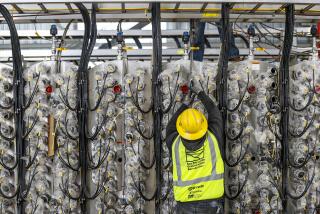EPA to Cap Dump Site in Fullerton
FULLERTON — Thirteen years after the McColl dump was declared a federal Superfund site, the federal government has decided on a cleanup plan--placing a thick cap above the contamination as a protective cover.
The announcement Thursday is being welcomed by nearby residents who said they much prefer the cap to a more complex cleanup scheme initially favored by the U.S. Environmental Protection Agency.
“After all these years, we do feel that it’s going to be resolved,” said Debbie Bushey, who lives close to the 22-acre McColl site.
“The people are just very much in favor of getting the whole thing done after 20 years,” said A. Richard Olquin, board member for the Fullerton Hills Community Assn.
EPA officials said that area residents’ concerns influenced their decision to choose capping. That approach also is favored by the four oil companies that have been ordered to clean up the site where petroleum waste was dumped during World War II.
The cleanup is expected to be completed in two to three years, with the estimated $30-million cost borne by the oil companies and perhaps the federal government.
A spokesman for the oil companies said Thursday that the cap could be designed and implemented in as little as two years.
The companies are “fully supportive of the EPA’s decision” in favor of the cap, said Kent Rogers, manager of remediation for Shell Oil Co. and spokesman for the McColl Site Group, which includes Shell, Atlantic-Richfield, Texaco, and Union Oil of California.
The oil companies had opposed an earlier plan favored by EPA that called for injecting a cement-type substance into the ground to neutralize the waste. The technique, called solidification, would have cost up to $98 million and taken four to six years.
After tests early this year turned up problems with the technique, EPA officials announced in July a preliminary preference for capping, and the final decision was made after a public comment period.
The cap will prevent water from getting into the waste while blocking emissions from escaping into the air, federal officials said. The project may actually consist of two caps, with layers that could include high-density polyethylene and a synthetic clay liner, Rogers said. A gas collection mechanism would collect any emissions and route them to a small treatment system.
Although designing the cap may take a year, it will probably be about four feet thick, with one or two feet of topsoil above it, Rogers said. Designers also hope to restore part of a nearby golf course.
The announcement of the capping plan comes during a turbulent era for the Superfund program, with environmental spending under intense scrutiny on Capitol Hill. But an EPA official said he is confident cleanup will proceed at McColl even if his agency’s budget is shaved.
“I’m optimistic that work will continue in that we have four major oil companies that have been found liable and are out there doing the work,” said Greg Ritter, assistant regional counsel for the EPA in San Francisco.
A District Court judge in Los Angeles has ruled that the federal government is liable for some of the cleanup costs. The decision was sought by the oil companies, who maintained that government regulations during World War II indirectly contributed to the waste problem, said Ritter at EPA. But it remains unclear how much of the price tag the government might have to pay.
(BEGIN TEXT OF INFOBOX / INFOGRAPHIC)
Capping Off Waste
The U.S. Environmental Protection Agency has agreed to a $30-million solution for the McColl dump in Fullerton. Plans call for a multilayer site cap, yet to be designed. Work is scheduled to be completed in two to three years. The site’s toxic history:
Buried in ‘40s
In the 1940s, oily sludge was poured into 12 pits at the McColl site. Later, mud produced by nearby oil drilling operations was dumped to cover the highly acidic sludge.
Concern in ‘70s
In warm weather, some soft sludge seeps to the surface. It emits fumes and contains several cancer-causing chemicals. Complaints about odors and health problems began after homes were built nearby in the 1970s.
Sources: Environmental Protection Agency. Fullerton Planning Department, McColl Site Group.
More to Read
Sign up for Essential California
The most important California stories and recommendations in your inbox every morning.
You may occasionally receive promotional content from the Los Angeles Times.









